Advent 2 - Taize Evening Service
Posted: Tue, 5 Mar, 2024 (2 years ago) - by Liam
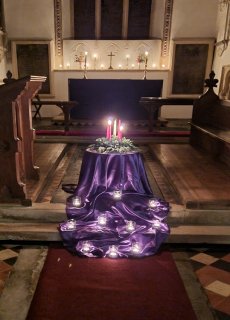
On Sunday December 10th we gathered silently in Woodton church, by candlelight and torchlight, for a quiet, reflective service in the Taizé style, involving prayers, readings and periods of silence, interspersed with its distinctive songs and melodic chants.
Founded in 1940 and home to over 100 brothers, both Catholic and Protestant, from all over the world, the Taizé monastic community is a major site of global Christian pilgrimage, attracting tens of thousands people each year, mainly, though not exclusively, young Christians. Over the years several people from our benefice have visited Taizé and all of them regard it as very memorable experience.
Those at Woodton have provided feedback which speaks of the powerful effect of the simple liturgy, the beauty of the music, the atmospheric setting for the service and the opportunity, much appreciated, to be still, to contemplate and reflect:
Prepare the way for the Lord,
Make a straight path for God.
Prepare the way for the Lord.
Amen
Back to top of page
My heart Leaps up when I behold a rainbow in the sky.
Posted: Thu, 12 Nov, 2020 (5 years ago) - by John

If you have a favourite poem, why not come and share it (and perhaps the reason it is a favourite) on Saturday 21st November at our zoom Poetry Evening. This will start at 7pm, it is a fund raising event for the Benefice and the cost to take part is £5. Please email or telephone me if you would like to take part and put £5 either through my door (22, Brecon Road, Brooke) or Lynn's (The Vicarage, Brooke). You will be given the zoom code on Friday the 20th. I look forward to seeing you there. John Ash, 01508 550116 johnrvash@gmail.com
Back to top of page
Thoughts on St Peter
Posted: Mon, 15 Jun, 2020 (6 years ago) - by John
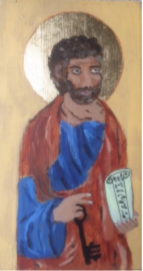
One of the things I have missed over the past 12+ weeks has been walking up the Church Path in Brooke and looking up to see the statue of St Peter above the porch entrance before entering the church.

Why? Peter was an ordinary fisherman – skilled at his work no doubt and not particularly well educated. He became a trusted and liked follower of Jesus, but he was not perfect – so there is hope for us all. And thinking of this as I pass the porch gives me a feeling of confidence- confidence that we do our best in whatever God has set us to do and sometimes we will fall short – but God will still love us.
Peter of course was commissioned by Jesus with the rest of the disciples “to make disciples of all nations”. He was successful in this traveling around spreading the ‘good news’ finally ending up in Rome. Here Emperor Nero was persecuting Christians and Peter’s fellow Christians implored him to leave Rome to spare his life. He did not run away and was put in prison where he converted his gaolers Processus and Martinian. He was taken from the prison and crucified, head downwards at his own request for he declared himself unworthy to suffer the same fate as his Lord.
It is not surprising that so many Churches are dedicated to St Peter, the disciple who carried out Jesus’ teaching to the letter (and to death) and a saint to be an example to us all. So taking two extreme examples Brooke and St Peters Basilica in Rome. On the face of it they may not have any similarities – but of course they have. St Peter’s in Rome may be more lavishly decorated (and have more gold) but both places provide a meeting place for Christians to praise God, to pray and hear the Good News of Jesus Christ, and have done that for many hundreds of years.
I sometimes think that St Peter would feel more at home in our Church, his coming from a village and a working family background, but who knows, he may prefer the enormous crowds in Rome to be able to carry out Jesus’ commission to make disciples of all nations. When I was in St Peters in Rome there were certainly hundreds of people from all nationalities.
Over the last 12 weeks my days have comprised gardening, doing odd jobs that I had been putting off (for years) and a bit of painting as the Thursday art group cannot meet. The challenge I set myself this week was to paint an icon – a painting of a saint on wood. My effort of St Peter is below – nothing like the icons I have seen in Russian Orthodox Churches – but I enjoyed doing it!!
Back to top of page
Our Reader Writes.....
Posted: Thu, 16 Apr, 2020 (6 years ago) - by John
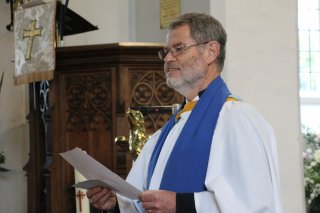
Dear Friends,
The last few months have been difficult for many people here in Britain and across the world. We have experienced the wettest February for years, bringing floods to many parts of Wales and England with families having to evacuate their home and many of their treasured possessions lost. There have also been floods in other parts of the world, where individuals and governments do not have the help and infrastructure to be able to respond effectively. This came soon after the terrible fires in Australia and America. And then, if that was not enough, we (as I write) have the worry of Coronavirus, how widespread will it be, must we cancel holidays etc. It seems as if the floods and pestilence we read about in the Old Testament are revisiting us. However, I do not think that is the case. The scientific advice is that the floods, fires and viruses are partly our own making. Climate change, due to the ‘misuse’ of our planet and its resources, is now having a devasting effect on peoples’ lives as are these new strains of viruses.
So, in short, we are living in very uncertain times. How do we deal with what is happening around us, how will it get worse (or better) in the future, what can we do? I am sure many of us feel at a loss and perhaps rather afraid.
If we step back 2000 years, the disciples and Jesus’ close friends must have had similar feelings. What was happening? Jesus had been tried on untrue charges and then crucified on the cross on Good Friday. What would happen to them? What did the future hold? It was a very uncertain time, but they stuck together – the disciples and Jesus’ mother and a few other close friends. There was obviously a feeling of security and companionship in being together and sharing the difficult time they were experiencing – there was not much very good about that Good Friday. But it all changed on that first Easter Day with Jesus’ resurrection and we read in Matthews Gospel that he appeared to them and told them that “I am with you always, to the end of the age”. All was not lost and there was a much brighter future than they had feared.
In our difficult and uncertain times, we can stick together and support each other, doing what we can for each other and the world. Remembering always that Jesus is our Saviour and is with us always to the end of the age.
I would like to finish this letter on a personal note. I have been through very uncertain times over the past six months dealing with my cancer. I would like to thank you all for your goodwill messages and prayers. They meant an awful lot to me and really did help during the difficult periods of chemotherapy and post operation.
May God bless and keep you and may you have a very Happy Easter,
John
John Ash
Lay Reader
Back to top of page
Churchyard Notice Board
Posted: Sat, 14 Mar, 2020 (6 years ago) - by Diana
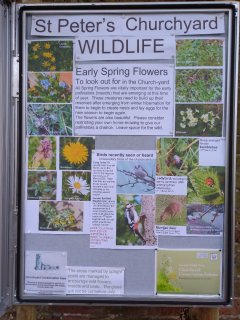
There is now a noticeboard close to the entrance to the Brooke Churchyard displaying information about the wildlife which can be found in the churchyard, updated seasonally
Back to top of page
May ’18 Winged and Floral Delights, St Peter’s Patch
Posted: Sun, 13 May, 2018 (8 years ago) - by Diana
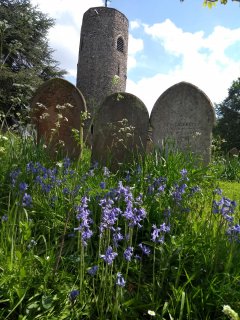
Leaving behind the Flower Festival displays on Sunday 6th May, I walked into the strong late afternoon sunshine which heated the East end of the churchyard by the wood. The stage was set for another glorious display of the weekend. Into the sunlight danced six different types of butterflies although not fluttering together but generally taking their cue one by one over the course of an hour.
The most obliging individual was a “Comma” which offered some patient watching as it warmed its wings sitting on Cow Parsley, some grass cuttings and bare earth. I managed to photograph it when in this resting position. It looks as though its wings have been ripped like a torn paper. It doesn’t have the smooth outline of the “Small Veined White” which also obliged me enough to warrant a photo but it’s camouflage gives a “Where’s Wally” type puzzle! There were also two small whites fluttering about.
A Peacock butterfly made a brief entry. A Holly blue became a brillliant bright surprise visitor although later, on leaving there were two dancing together outside the Old Vicarage hedge. Over the previous afternoon an Orange Tip had been fluttering over the gravestones at great speed. The Male Orange tip lives up to its name and is easily spotted on the wing dallyancing until it’s pale winged mate is located. I managed a photo of a female in my garden this week feasting for a moment on the one Lady’s Smock that’s sprung up this year. Again – you have to look hard at the photo.
There is a legend that the mother of Constantine the Great, St Helena, found a smock in a cave near Bethlehem, left by the Virgin Mary! The flower lhas been said to look like little smocks hung out to dry.
And no spring post would be complete without bluebells, here with the Bell tower behind taken this week.
To view all images, look in the Churchyard album via The Gallery.
Back to top of page
Two Seasons in One Month! A Beast from the East and soft Easter rain
Posted: Mon, 9 Apr, 2018 (8 years ago) - by Diana
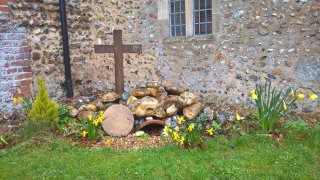
Saturday March 3rd, we dared walk out into the snow-covered roads and paths and down to the Churchyard. It was one of the first days following the several snowfalls of the preceding week that the “beast” had stopped its’ howling. In St Peter’s Churchyard the wildlife felt comfortable enough to venture out and we found the tell tale tracks. Pheasants and partridges had come out of the wood at the north east end and made the snow look like a busy thoroughfare. On the opposite corner, by the boundary with the Old Vicarage, a hare had lolloped its way from the wood to the safety of the wall - it’s tracks longer and larger than a rabbit - more of a longjumper.
Good Friday, March 30th, soft rain began to fall in the afternoon. The tombstone on the Easter Garden was sealed to represent the after noon when Christ’s body was placed within. A walk into the churchyard revealed the blessings a few degrees of warmth had brought since the “beast” had left us. To be seen still are wild primroses both yellow and pink - not all primroses are yellow, even in the wild. Some have almost pure white flowers while others have a pink or purplish tinge. Under the hedge boundary with Dovecote are the most stunning royal purple violets, like jewelled amethysts in the grass. The snowdrops, though, are showing their final flowers before hiding underground for another year. Up from underground venture the small burrowing mammals; photographed here a clear hole, probably for a mouse, under the lea of an old gravestone, perhaps Mrs Tittlemouse getting ready for her spring cleaning! What will a few more degrees of warmth reveal in April?
View the Churchyard Spring 2018 photo gallery for more images.
Back to top of page
Harvesting Our Gifts
Posted: Thu, 9 Nov, 2017 (8 years ago) - by Alison

A huge thank you for your wonderful support for St. Peter's Church's celebration weekend 'Harvesting our Gifts' on 30th September and 1st October.
The Church looked stunning with floral and fruit displays and displays about how St. Peter's serves God and serves our community and beyond. The weekend culminated in a lovely Harvest Festival service of praise and thanksgiving.
A total of £1966 was raised, including Gift Aid, for which we are especially grateful. It will all be put towards the continuing work and upkeep of this very special place in our community.
Heartfelt thanks once again. May God richly bless you.
Back to top of page
April in St Peter's Patch
Posted: Thu, 1 Jun, 2017 (9 years ago) - by Diana
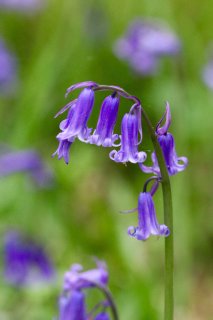
Bells and bells
In the 14th century bluebells were first recorded and described by a Friar Henry Daniel as “lilies of the wood…. like daffodils but blue”. Reflecting of Victorian imagery, their depiction in our Lady Chapel window in the 1930’s, would have been to symbolise sorrow; their bell heads hung in sadness at Christ’s crucifixion.
In contrast, the Woodland Trust this spring ran a campaign to record all British bluebell sightings in the UK to celebrate their glory….. My family and I went on two bluebell “pilgrimages” to Foxley Wood near Fakenham and then Sisland Carr next to nearby Loddon. But, in our own St Peter’s Patch we have only one patch behind the front railings, but I am pleased to say that these are English bluebells, not the Spanish import.
For St Peter’s April was bells month. The bells project in the tower: the installation of the new frame, the redecoration of the ringing chamber and the re-hanging of the bells was speeding to its conclusion throughout April. So in honour of our splendid St Peter’s bells I am writing about bluebells. In Brooke there were more in flower around the Meres than in the churchyard. Perhaps this is apt as the church bells ring out for us all to hear throughout the village.
“There is another quality that makes the bluebell magical: it is in a hurry… The flowers have to beat the closing over of the tree canopy and their rush to become themselves is what makes them taut and glossy”… “ It doesn't last; as soon as they are perfect, they are over. Within a couple of weeks, the entire population will be drowned as if a flood has run through the wood. Now is the moment: it's when spring turns into summer.” So wrote the writer and historian Adam Nicolson in the Guardian in the spring of 2010.
This was such an apt quote for our April in St Peter’s: “in a hurry”. Everything had to be ready for the visit of Bishop Graham Norvic to rededicate the bells in a special service. You can’t slow down the progress of spring to summer and as a church we could not delay for the great moment of the special church service on May 7th.
Back to top of page
Brooke Bells ring out good news
Posted: Mon, 8 May, 2017 (9 years ago) - by John

The bells of St Peter’s Church in Brooke rang again on Sunday 7th May following six months of being silent to rehang them in a new frame. Last November, the bells were taken out of the tower to be fitted with new headstocks, wheels and clappers and returned in April to be rehung in the newly installed steel frame. The work has been carried out by John Taylor and Co bellhangers assisted by local volunteers. The bells were rededicated by the Bishop of Norwich, Rt Rev Graham James at a special service on 7th May at 6.30 in St Peter’s Church. The service included commissioning the ringers to ring the newly rehung bells and they were rung by the local band as part of the service with open ringing afterwards.
Thanks to grants from the Heritage Lottery Fund (HLF) and the Norwich Diocesan Association of Ringers and donations from villagers and the Friends of St Peters, the project will ensure the bells ring out for the future. New fittings were last installed in 1912 and this project, which was awarded £58,900 from HLF, should see them lasting for the next 100 years.
The six bells were installed in the existing timber frame in 1758 by Joseph Mallows of Dereham and are the best surviving example of Joseph Mallows bells in the county. The bells in the new frame are ‘easier’ to ring and this will encourage more people, especially younger ones, to take up this ancient skill. The National Lottery funded project has also included community involvement from the local history group, scouts and the village school.
Dawn Pullan, the ringing master said: “We now look forward to regular ringing again and welcoming new ringers to ensure that the bells are heard throughout the village for many years to come. I would like to thank all those who have generously donated time and money to this worthwhile project.”
Back to top of page
March Days 2017
Posted: Sun, 9 Apr, 2017 (9 years ago) - by Diana
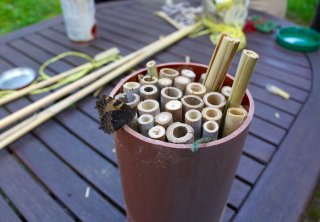
“It was one of those March days when the sun shines hot and the wind blows cold: when it is summer in the light and winter in the shade.”
So wrote Charles Dickens in Great Expectations. We stood outside the side door of church last Sunday morning (26th) during our Mothering Sunday Café Church making bug boxes for St Peter’s Patch. It was extremely warm in the lovely March sunshine although a few hours earlier, we would have felt the chill of winter in the same spot.
As if on cue, as the young people were assembling their bug hotels, using sections of bamboo and hollow plant stems packed into lengths of drainage pipe, a Small Tortoiseshell butterfly landed nearby and posed for a photograph. Some hibernate throughout the winter. Today also the ladybirds were warming up and flying around.
The three bug boxes made that morning are now hung under the conifers on the north side of the Churchyard. Ladybirds like to hibernate in the nooks and crannies in dead wood, and the homemade artificial homes can mimic this.
Lacewings are pretty insects that like similar accommodation to help make it through the winter. Such minibeasts like a chambered box to stay when it’s cold and they’ll have a better chance of waking up in the spring.
In the grassy areas of the churchyard the ground is green with long grass shoots and the woodland plant species are in flower. Early lesser celandines open their yellow petals in the sun, however when it’s dull the flowers remain closed. Red deadnettle and mouse-eared chickweed are also growing in abundance under the blue cedar tree in the front churchyard.
We most associate the primrose with this time of year. There are carpets of them on the back lanes into Brooke at the moment. St Peter’s churchyard, however, is not quite so well endowed although we photographed a few. They like to set seed in well-drained grass around early July.
Our native birds time their breeding season to the warmest part of the year, when there is plenty of food and lots of daylight in which to find it. As winter turns to spring, the lengthening daylight switches male birds into breeding mode. We watched starlings and robins together with coal tits, blue tits and gold finches in the tree cover on the eastern and northern boundaries.
The Norfolk Wildlife Trust are working with us on a fabulous wildlife day in the churchyard on Saturday 24th June, 11 – 3, “Wild about St. Peter’s”. It will be free to all. Save the date and find out more on further posts and watch out for posters and flyers nearer the time.
Back to top of page
Brooke Bells update – February 2017
Posted: Wed, 1 Mar, 2017 (9 years ago) - by John

| |
|
|
Taylors the bellhangers returned earlier this month to relocate part of the old bell frame in the sound chamber.
This was a requirement of English Heritage as they considered the 18th century timber frame to be of historical importance. We will be using the old frame to hang two dumb bells to help with teaching learners to ring. The old frame was lowered down in five sections and reassembled on new steel beams. The work went smoothly under the direction of Andrew from Taylors who was ably assisted by John Ash and Steve Hayman.
The new frame for the bells is now being constructed in the bell foundry and will be arriving at Brooke on March 21st. The bells will follow shortly after that and it is hoped that they will be in place and ringable by Easter (all being well and with no hitches).
We have not been idle while the bells have been away. New lights have been installed in the ringing chamber, sound chamber and bell chamber. The bell chamber has been cleared of rubbish and the rotten floor repaired. Charles Wilde has also done an excellent job of repairing cracks in the ringing chamber using traditional lime mortar and will be lime washing the walls during March.
|
| |
|
|
|
| |
|
|
|
| |
|
|
|
| |
|
|
|
| |
|
|
|
| |
|
|
|
| |
|
|
|
| |
|
|
|
| |
|
|
|
Back to top of page
The Flowers of Winter into Spring - mid February inspiration in St Peter's Patch
Posted: Thu, 16 Feb, 2017 (9 years ago) - by Diana
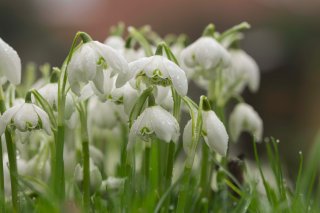
The flowers of late winter and early spring occupy places in our hearts well out of proportion to their size. ~Gertrude Smith Wister (1905–1999)
Despite this being a quote from a North American horticulturalist, it is nonetheless true here in Norfolk. We are in mid-February desperately longing for signs of spring and snowdrops are looked for with great excitement. There are quite a few clumps in the churchyard, particularly towards the south-east where the trees in the Old Vicarage overhang.
Common snowdrops flourish in leaf-litter enriched soil underneath trees. Even when the tree canopy is in full leaf the shady moist soil continues to harbour the right conditions for the nurture of the underground bulbs. The group photographed here are probably Galanthus nivalis with double flowers.
There is an established hazel tree on this same southern boundary in the corner of the old vicarage garden just next to the current churchyard compost heap. Hazel has many stems as opposed to a single trunk. It’s branches lean out some way into St Peter’s Patch from which hang pendulous yellow catkins. On the same twigs are tiny crimson flowers looking like red fingers reaching out from the nascent leaf buds. These are the female flowers that are pollinated by the wind-blown pollen from the catkins. The female flowers go on to form the nuts. We’ll have to see just how many in October when they’ll be ripe for picking.
We are currently between Candlemas and Lent in the church calendar. The snowdrops are sometimes called Candlemas bells as they are generally out for the Feast of the Presentation of the Infant Christ in the temple on 2 February.
This year there are four weeks between Candlemas and Ash Wednesday (1 March) when the fourty days of Lent begin (the period of preparation before Easter-tide).
The daffodil, particularly the wild narcissus is sometimes known as The Lenten Lily. Right now, there are plenty of long leaves emerging ready to be followed by the yellow flowers in a few weeks; so they’ll be in flower during Lent and probably out for Mothering Sunday on 26th March.
All are warmly invited to our Mothering Sunday Café in Sunday 26th March in St Peter’s Church from 10.30am where they’ll be coffee, squash, cake plus craft and other activities to celebrate mothering.
Back to top of page
A Cold Damp Sunday in Late January 2017
Posted: Thu, 9 Feb, 2017 (9 years ago) - by Diana
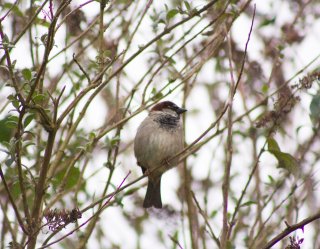
Observations are just that. Rural residents see so many things in the process of going about our daily lives that we tend not to “notice” the obvious which might draw attention in an urban site. For example, a pheasant walking down a drive in central Norwich would cause excitement but most of us see them regularly in our gardens and roadsides and therefore discount them.
This visit to St Peter’s Patch in late January is like that; we saw things that are around about us in the village but yet we can relish and celebrate what we have and can be seen in this peaceful sanctuary.
Luxuriant overgrown hedges and small trees on the northern boundary attract many small birds. Today we saw:
Sparrows, long-tailed tits, blue tits and robins.
On that same northside of the front churchyard near the wall with Dovecote, and over ancient headstones, ivy has become one of the dominant plants but their winter berries are a source of food for small birds.
At the east end of the churchyard there is a woodland boundary in which sat pigeons and rooks with occasional flights overhead plus a common gull in soaring glide.
Some of you might have seen the amazing images of starling murmurations on BBC Winterwatch last week. In winter the British starling’s numbers are swollen by migrants from northern and central Europe and it is then when their aerial manoeuvres en masse happen. At about this time of year male starlings start building an untidy nest of leaves and grasses that is completed by the female before egg-laying. They like to nest in trees, rocks and buildings. High up on the north east corner of the church where the Lady chapel ends, just under the guttering, you can see the recent bird droppings of one of these males who is getting ready to invite his mate to join him in the next couple of months.
Molehills are abounding at the moment. Apparently moles thrive best in permanent pasture so are in an almost ideal habitat in a churchyard. Clearly judging by the number of molehills spread throughout the patch, this is a good place to be for Moldy Warp. There’s probably an abundance of worms!
The photographs of the red-legged partridge on the south wall bordering the old Vicarage were taken a week ago. Apparently there are about two dozen birds currently living in and around the churchyard. Males will frequently perch on vantage points in their territories, such as the high boundary wall. It is an attractive game bird and is probably eating beech mast and other seeds from the deciduous trees that grow on the boundaries.
Back to top of page
St Peter’s Patch, Brooke Churchyard
Posted: Thu, 9 Feb, 2017 (9 years ago) - by Diana
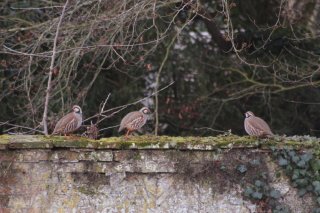
Introduction
“In order to know it properly a landscape requires routine and repetition… Nature keeps it own pace. To do things routinely, to take the same walk time after time, is not to see the same view over and over. It is to notice the incremental rate of natural change and to appreciate that nothing is ever repeated.” So writes Mark Cocker in his introduction to “Claxton”, 2014.
Local writer Mark Cocker delighted in publishing twelve years of notebook observations collected in monthly chapter headings made as he walked out of his front door in the South Yare Valley (which just happens to be a few miles down the road from Brooke.)
Bill Oddie writes and broadcasts about his going out and about in his own local patch on Hampstead Heath noting what he sees. The BBC Springwatch team base their broadcasts on observations made in one location over three weeks in early summer.
In his article in Brooke Parish Magazine in August 2016, Philip Strachan wrote about the great possibilities for exploring and learning about local nature in our own little reserve surrounding St Peter’s Church. Churchyards can be great places for wildlife and are often full of wildflowers. In fact, as Philip explained, the Parochial Church Council (the group of individuals involved in running and managing the church and its activities), now have an initial survey of the plants in the churchyard undertaken by the Norfolk Wildlife Trust. It covers a snapshot in time in late July 2015 and the plants manifested then.
One of the uniquely interesting factors of churchyards in the 21st century is that in thousands of communities, ours included, there are sizeable areas of land – usually about an acre- that has survived untouched by either urban development or intensive agriculture. In many instances this “set-aside” element even pre-dates the church foundation because it was usually based on common land. This means, that, unlike our gardens and fields, there are unique reservoirs of wildlife that are not necessarily replicated elsewhere. “As such, churchyards have assumed an importance not only for the people of the parish but for its wildlife also.” Francesca Greenoak in “God’s Acre”, 1985.
Given that St Peter’s, Brooke now has a website which is regularly updated with news and activities, a group of interested individuals want to try observing “St Peter’s Patch” on a regular basis and sharing what we see there with some photographs. We want this to be an inclusive experience and as so many Brooke residents visit the churchyard regularly, please do share observations so that we can build a picture of the wildlife in St Peter’s Patch.
Diana Wilde
29th January 2017
Back to top of page
The Bells have gone!!
Posted: Mon, 28 Nov, 2016 (9 years ago) - by John
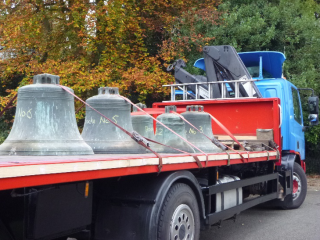
On Monday 31st October Andrew, the bellhanger from John Taylor and Co, duly arrived to remove the bells from the belfry. The scaffolding had already been erected, strong enough to carry the weight of the tenor bell at 14cwt (700kg). ably assisted by John Ash and Steve Day the first job was to install a lifting beam inside the tower. The after removing the louvres to the SW opening work started on lifting the bells out of the frame, moving them across the tower and scaffolding and lowering them to the ground and then into Church for safe keeping. All went to plan with the 4th, 3rd, second and treble bells removed by Tuesday evening followed by the 5th and tenor on Wednesday. Wednesday afternoon and Thursday saw half the 1758 oak frame removed which as you can imagine was quite an undertaking. WE marvelled at the skill of those carpenters who put the frame together with no power tools, tenon joints and dowels on a large scale. The other half of the frame is to be saved and placed in the sound chamber to hold the dumb bells.
Friday morning and the lorry arrived to take the bells to the bell foundry in Loughborough. They were loaded and disappeared down the street with a touch of sadness and you can image my relief when I heard that they had safely arrived in Loughborough that afternoon. Now we have to clean out the years of accumulated birds nests etc. move the rest of the frame and wait for the bells to arrive back in February.
John Ash
Back to top of page
Brooke Bells ring out good news
Posted: Wed, 27 Jan, 2016 (10 years ago) - by John
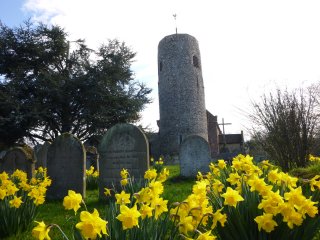
St Peter’s Church and the bellringers received an excellent Christmas present just before Christmas. The grant application to the Heritage Lottery Fund was approved and we have a grant of 80% towards the total cost of £75,000 to rehang the six bells. This really is good news as competition for grants is fierce. The project is to rehang the bells in a new frame with new bellfittings which will make them easier to ring and they should last for another 100 years. The bells were last rehung in 1912 and the timber frame was installed in 1758. The project also includes community involvement and there will be more details regarding this aspect of the project in due course. A contract has been let for John Taylor & Co
January 2016
John Ash, Fabric Officer; Dawn Pullan, Tower Captain.
Back to top of page
Parish Magazine Letter April & May 2014
Posted: Sat, 22 Mar, 2014 (12 years ago) - by John

In the last fortnight I have attended two talks which in different ways dealt with spirituality.
In a world of ‘must have’ and instant communication, spirituality (to do with understanding our inner self) is important I believe, if we as Christians are to act responsibly in the world in which we live.
The first talk was about Julian of Norwich, who as many of you may know lived in Norwich in the 14th century, and whilst very ill at the age of 30 experienced a number of visions. She recovered from her serious illness and spent the next 40 years locked in a room adjoining St Julian’s Church. Here she not only gave advice and comfort to those who visited her but also wrote down what she had learnt from the visions in a book “The Revelations of Divine Love”. This book, the first ever to be written by a woman, took 20 years to write and is now regarded as a spiritual classic throughout the world. Her clear thinking and deep insight speak directly to today’s troubled world. She was clearly ahead of her time and her understanding of God’s love was that of a tender loving mother, as well as that of a father – more 21st century than 14th !!
The second talk was given by Brother Sam of Hilfield Friary in Dorset. He is a Franciscan brother and very much in today’s world. He suggested that our spirituality was formed by a mixture of: the environment; the community in which we live or have lived; those on the margins of society that we come into contact with; and our prayer life. His discussion linked all four areas to the life of St Francis who was not just a lover of animals as he is so often portrayed, but a well-educated man who renounced his well-off background to work in the world, providing love and care to those in need of help, the poor and the sick, but also with a deep understanding that everything; humans, birds, animals, rocks, landscape, etc. are all from God. We are after all, made up of the same chemical element building blocks so are all interdependent.
The message that I took from the day was one of a need for us to engage in practical sharing both in our community and in the world, doing things together and seeing the world more through Gods eyes.
You can visit Hilfield Friary in Dorset or attend one of their courses and The Revelations of Divine Love can be bought or borrowed from the library – I recommend the latter, and the former if you are in that area or are in need of spiritual refreshment away from home.
May God keep and bless you.
John Ash
Lay Reader
01508 550116; sjash@waitrose.com
In the absence of a Vicar, if I can be of help or if there are any issues you would like to discuss please do not hesitate to contact me (phone or email).
Back to top of page
Norwich foodbank
Posted: Wed, 19 Mar, 2014 (12 years ago) - by Ruth

Help make a difference.
Buy a little extra to donate to the Norwich foodbank.
Shopping lists are available from the Village collection at St Peter's Church open daily 9.00 - 4.00.
Several trips have been made to the Centre with all your contributions. Please continue to support this worthy cause.
Back to top of page

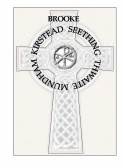
 Advent 2 - Taize Evening Service
Advent 2 - Taize Evening Service My heart Leaps up when I behold a rainbow in the sky.
My heart Leaps up when I behold a rainbow in the sky. Thoughts on St Peter
Thoughts on St Peter Our Reader Writes.....
Our Reader Writes..... Churchyard Notice Board
Churchyard Notice Board May ’18 Winged and Floral Delights, St Peter’s Patch
May ’18 Winged and Floral Delights, St Peter’s Patch Two Seasons in One Month! A Beast from the East and soft Easter rain
Two Seasons in One Month! A Beast from the East and soft Easter rain Harvesting Our Gifts
Harvesting Our Gifts April in St Peter's Patch
April in St Peter's Patch Brooke Bells ring out good news
Brooke Bells ring out good news March Days 2017
March Days 2017 The Flowers of Winter into Spring - mid February inspiration in St Peter's Patch
The Flowers of Winter into Spring - mid February inspiration in St Peter's Patch A Cold Damp Sunday in Late January 2017
A Cold Damp Sunday in Late January 2017 St Peter’s Patch, Brooke Churchyard
St Peter’s Patch, Brooke Churchyard The Bells have gone!!
The Bells have gone!! Brooke Bells ring out good news
Brooke Bells ring out good news Norwich foodbank
Norwich foodbank
















